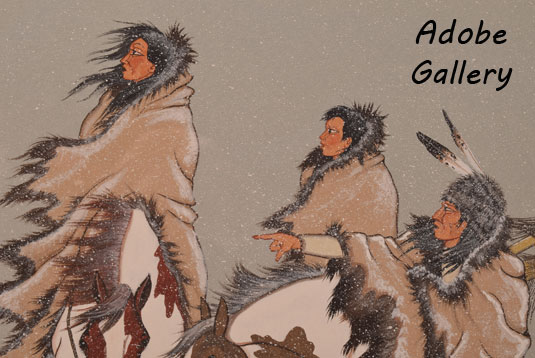Untitled Comanche Painting of Winter Travelers by Doc Tate Nevaquaya [SOLD]
+ Add to my watchlist Forward to Friend
- Category: Paintings
- Origin: Comanche Nation - Lords of the Plains
- Medium: watercolor
- Size:
22” x 18” image;
32-1/4” x 27” framed - Item # C4155K SOLD
This untitled painting by Doc Tate uses its size to its advantage in a creative manner. It's a large piece, measuring 22 inches in height and 18 inches in width. Tate's subjects—three wintertime travelers wrapped in buffalo-hide robes, two of whom are on horseback—occupy only the center of the ovate image. The large frame extends the empty space even further, creating a huge presentation, over which only a small portion is painted. This arrangement is dramatic and unusual. It effectively heightens the impact of the scene. Tate's travelers are impeccably crafted. They're pictured head-on, travelling towards the viewer, but turning to the right in unison. A man, leading the procession on foot while carrying a bow and a quiver full of arrows, points towards whatever has captured their attention. Their thick blankets hang horizontally to their right sides, suggesting that the winds are howling. A small area of snow-covered ground sits beneath their feet, leading back towards a distant row of trees. Other than this cluster of action in the center, this image is all snow. Tate's soft white speckles cover the entirety of the image. They're densely concentrated around the center, becoming sparser around the edges. This is a charming image that is made even more attractive by the unique way it is presented.
![]() Doc Tate Nevaquaya (1932 - 1996) was a Comanche painter and musician. He was given the name Joyce Lee Tate Nevaquaya when he was born in 1932 at Apache, Oklahoma. He had been delivered by a physician named Dr. Joyce, and the family honored the doctor by using Joyce for their son’s first name. He was nicknamed Doc, most likely because of his relationship to the physician. He was always known as Doc Tate. He was orphaned at age 13 and went to live with his grandparents, thus strengthening his relationship with his Comanche heritage.
Doc Tate Nevaquaya (1932 - 1996) was a Comanche painter and musician. He was given the name Joyce Lee Tate Nevaquaya when he was born in 1932 at Apache, Oklahoma. He had been delivered by a physician named Dr. Joyce, and the family honored the doctor by using Joyce for their son’s first name. He was nicknamed Doc, most likely because of his relationship to the physician. He was always known as Doc Tate. He was orphaned at age 13 and went to live with his grandparents, thus strengthening his relationship with his Comanche heritage.
Doc Tate was a man of many talents. He was a teacher, minister, lecturer, historian, dancer, composer, singer, flautist, and painter. His interest in the courting flute—a traditional instrument that is played by many American Indian tribes during courtship and fertility rituals—began in childhood and eventually became his primary creative interest. Tate became an accomplished flautist, instructor, and lecturer and was one of the leaders in a 1970s revival of the courting flute. Later in life, he released two recordings of his courting flute compositions. He also taught his three sons to make and play flutes.
Condition: this Untitled Painting of Winter Travellers is in excellent condition
Provenance: from the large collection of a New York resident
Recommended Reading: The Biographical Directory of Native American Painters by Patrick Lester
Realtive Links: Comanche, Native American Paintings, Doc Tate Nevaquaya

- Category: Paintings
- Origin: Comanche Nation - Lords of the Plains
- Medium: watercolor
- Size:
22” x 18” image;
32-1/4” x 27” framed - Item # C4155K SOLD



